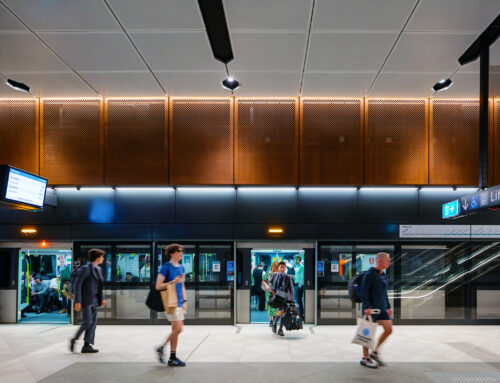Cross laminated timber (CLT) is a modern building material produced by glue-laminating planks of timber together and layering them to form a rigid, multi-layered panel. It can be used in building construction to form slabs, walls, and roofs.
CLT is becoming an increasingly popular building material for several reasons. Pre-fabricating CLT panels can provide an advantage over concrete construction due to shorter construction time, more consistent quality and easier maintenance. The use of timber can also be a more sustainable option than concrete, as it’s made from renewable materials and has lower embodied carbon. This more sustainable choice of construction materials can help developers, building owners and employers reduce the carbon investment of their building.
Timber, especially if it is visible, can be the go-to natural material for architects. Research suggests that natural materials not only look good in the built environment, they can also have tangible benefits for the people who use the spaces. Here are some highlights from research on design that incorporates nature:
- We spend 90% of our time indoors and long for the natural environment.
- Exposure to nature produces positive emotions that contribute to health and wellbeing.
- Incorporating regional features in buildings may generate a sense of place and community.
Bringing together architectural vision and acoustic solutions
An essential part of any ambitious building project is early collaboration between the architect and engineering team. When working with architects, we take time to really understand what an architect’s trying to achieve and the reasons behind their design. This helps us to create acoustic solutions that benefit the user, the building and the environment.
The seemingly irreconcilable differences between architectural design and acoustic design
The advantages of CLT construction come with some additional design considerations for fire, structure, and acoustics (and others of course). Some of the acoustic considerations for CLT buildings can superficially contrast with some of the other benefits, for example adding acoustic materials to cover the CLT. This article explores some of these considerations, and how they can be coordinated into a sustainable, attractive, functional building.
The 3 areas we explore in acoustics – echo, privacy, and noise
There are three key acoustic considerations that influence the performance of a CLT building.
- Echo – this is known as reverberation in acoustic engineering and relates to how sound behaves within an enclosed space. Does the space sound loud and echoey, or does the space deaden sound and reduce how far it travels? A highly reverberant space will tend to have hard materials like concrete, glass, plasterboard, and timber. Materials like acoustic ceiling tiles, carpet, upholstery, curtains, and soft acoustic panels will reduce reverberation.
- Privacy – sound insulation, or acoustic privacy, relates to how a wall, floor, or facade blocks noise transfer from conversations, road traffic, building services and footfall, amongst other things.
- Noise – ambient noise level reflects the overall noise level within a space, typically an accumulation of external noise from traffic and noise from ventilation systems.
Helping architects realise their design aspirations
The architects we partner with think big. They challenge traditional design and approach projects with an anything-is-possible mindset. These are some of the biggest acoustical challenges they need us to work on.
No ceilings or high ceilings
Walking into a room without a ceiling gives us the feeling of space. There’s more natural light and greater potential for creative design, including areas to meet and mingle. This can create character and encourage community and connection.
Traditional ceilings are made of mineral fibre ceiling tiles – a hard-working acoustic element of many commercial fitouts. The tile has some weight which helps to block noise from heating, ventilation and air conditioning within the ceiling. The tiles are sound absorbing, so they reduce reverberation from sound bouncing around a space. The ceiling also improves the overall performance of the floor structure, reducing noise transfer between levels of the building. This multi-functional ceiling tile therefore leaves big shoes to fill when the ceiling is removed and the in-ceiling services are exposed.
We’ve worked on several CLT buildings in the education and commercial sectors without suspended ceilings and have found solutions to replace each of the functions of a traditional suspended acoustic ceiling tile.
In the Murdoch University New Academic Building in Perth, now known as Boola Katitjin, we designed a raised access floor with a deep cavity to improve the acoustic privacy between levels of the building. The floor cavity was also used for an under-floor air conditioning system, which reduced the amount of services exposed in the open ceilings. Using the raised floor cavity for ventilation also helped reduce ambient noise levels. The raised floor panels are relatively heavy and block noise from the ducts below. This helped quieten the air conditioning system.
The CLT was left exposed on the underside of the high ceilings to reveal the natural materials of the fitout. This exposed CLT was partially treated with acoustic panels to absorb sound and reduce the reverberation. The combination of these solutions – an access floor, under-floor ventilation, and acoustic panels under the CLT – came together to deliver all the benefits of a conventional tiled ceiling while allowing the desired architectural outcome.
Exposed CLT in apartments
Bringing natural materials into our homes fosters warmth and a sense of feeling welcome. They can make us feel at ease and connect us with our environment. Plants, natural fibres, wood and CLT are all popular choices.
Exposed CLT in apartments needs to be carefully considered to ensure privacy. Walls, ceilings and floors need to control noise from footfall, music and talking as well as meet Building Code requirements.
We’ve worked with suppliers to test different acoustic systems in a lab and on project sites to verify performance. Our research, and work with clients, has concluded that both a fire rated ceiling below the CLT and a raised acoustic floor above the CLT, along with a suspended ceiling, provide sufficient privacy and achieve acoustic compliance.
A more straightforward acoustic challenge in apartments is to expose one wall of CLT. We took the opportunity to test the acoustic performance with a single CLT wall exposed in two vertically stacked apartments on a project in New Zealand. One concern in this scenario is that noise will travel vertically down the walls between apartments and compromise the acoustic performance of the floor and ceiling, in an effect called flanking.
In the scenarios we tested, the flanking had minimal impact on the compliance of floor and ceiling construction if one wall in each apartment was exposed CLT. This gives architects the option of revealing the visual warmth of the timber materials in an apartment, which is particularly beneficial when it’s the entry wall into the space. Typically, this wall has lower acoustic requirements and the timber provides a warm welcome. However, the exposed CLT also works on any wall that has plasterboard linings on the other side. This enables it to meet the required inter-tenancy wall performance.
Plant rooms
In building services design, materials need to be chosen carefully to make the most intelligent carbon investment. Here’s a question we encourage our clients to consider – where should we best invest our carbon? In other words, if they choose to build with concrete, how can this choice of material -which has a high embodied carbon value – be balanced with materials that have a lower carbon footprint.
Plant rooms can be some of the loudest spaces in a building, and therefore some of the more difficult spaces to design acoustically. In a concrete building, plant noise can be controlled with thicker slabs, floating slabs (under generators), and heavy walls. In a CLT building, the mass of the timber slab may not be enough to block noise from generators, chillers, pumps, and fans, so other solutions are needed.
We worked with architects on an office building in Geelong, Australia where we combined concrete and CLT to treat plant room noise invisibly, without compromising the aesthetic of the surrounding occupied spaces. In this building, the office areas all had exposed CLT ceilings, which was highly desired aesthetically. A simple acoustic solution to control plant noise would have been to put in ceilings below the plant room, but this would have compromised the aesthetics. Instead, the CLT slab inside the plant room was upgraded with a concrete screed on an acoustic underlay over the CLT. This provided additional mass and an isolating layer to control the plant noise, while retaining the consistent CLT structure in the building.
This approach is relatively common in Europe, but less common in Australia and New Zealand where dry raised floor systems are more commonly paired with CLT. The Geelong building used both systems for their strengths in different areas:
- The plant room used the concrete screed on an acoustic underlay over the CLT.
- The tenancy areas used a raised access floor over the CLT, with the raised floor cavity used for cable circulation and acoustic separation between levels.
Cross-laminated timber is good but isn’t for everyone
There are many benefits to CLT – it looks good, it makes us feel good and it has a lower carbon footprint than traditional construction materials. However, no building material is perfect.
- Developers, building owners and architects also need to consider what will happen at the end of the building’s lifecycle – will the timber be reused or demolished and sent to landfill? This influences the carbon investment they make.
- As we’ve illustrated, CLT alone isn’t suitable acoustically as a floor system. It’s often supplemented with a raised floor, suspended ceiling or both. This can increase the carbon footprint of materials needed for construction and space needed for installation.
- And of course, we need to consider floor-to-floor height which is always at a premium in any building.
It’s therefore essential to workshop the comparative strengths and weaknesses of CLT on a project early in the design, to ensure that the benefits of CLT can be incorporated into the building along with the other elements needed to make it work for fire, structure, acoustics and more.











